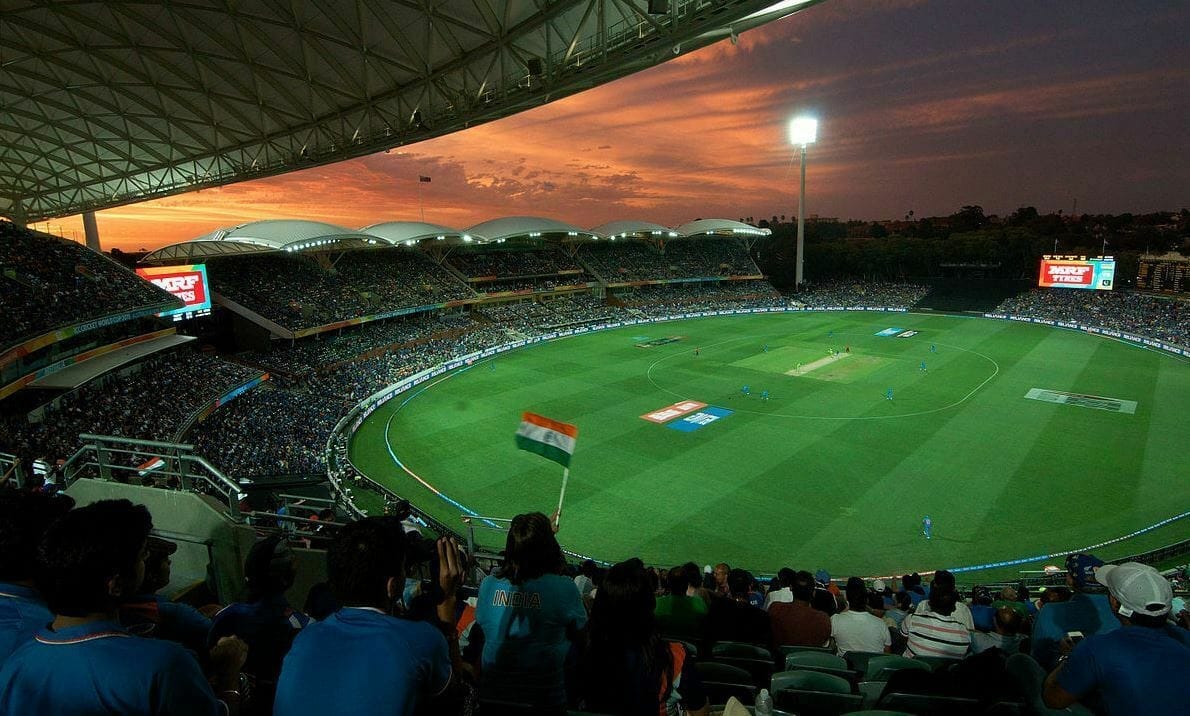Image: The South Australian skies turned a magical red on the day that India and Pakistan opened their account at the 2015 Cricket World Cup – at the new renovated, and beautiful Adelaide Oval Ground. Adelaide Oval – The sky is red, and the heart bleeds blue by Rajiv Bhuttan under Creative Commons Attribution 2.0 Generic license.
The final game of the interminable preliminary stage of the World Cup, between Pakistan and Ireland, ended in circumstances verging on the farcical. Umar Akmal, one of the tournament’s most aggressive and effervescent batsmen, played a succession of balls, of varying quality, quietly back to the bowler. He seemed very anxious not to score any runs.
The point was, there was an equation. It wasn’t the usual sort of time v runs v wickets equation. It was clear by now that Pakistan were going to win, and therefore qualify for a quarter final place at Ireland’s expense. No , the equation was: would Akmal’s partner, the opener Sarfraz Ahmed, be able to reach a century, his first in one day internationals and Pakistan’s first in this World Cup.
He managed it but really only because of Akmal’s vow of abstinence. Ahmed is a very good player indeed. His innings was almost flawless. He did run out the unfortunate Haris Sohail; and the end somehow spoiled the impact of the innings. It was almost as though the century was as significant as the victory itself.
The special interplay of the individual duel between batsman and bowler in the context of a team sport makes cricket peculiarly susceptible to the conflict between personal success and the common good. And the individual does not even need to be present. There is a case for saying that the most significant England cricketer in the World Cup was Kevin Pietersen, the only man to have scored more than one World Cup century for England. Of course he wasn’t actually playing: and, boy, didn’t we know it. Would England have done better if he had been playing? We can’t say. All we can say for certain is that they couldn’t have done any worse. By the time of the last rites of England’s abject campaign rumours were rife of a comeback by Pietersen in time for the Ashes. Given all that had gone before, who was bigger now, the team or the player?
It is the sort of question that can only be asked about the very greatest of players (sorry KP, not you). Cricket lore is full of stories of W G Grace remonstrating with umpires who had given him out: Sorry, my man, they have come to watch me bat, not you umpire. True , but it sort of misses the point. But in the last quarter of the nineteenth century Grace was the most famous man , not perhaps in the world, but in the British Empire. Queen Victoria was the most famous woman. That is a measure of his celebrity.
And after Grace, there was Bradman. The crowds would flock to watch him bat, in Australia and in England, and when he was out they would leave. In up country Australia when the Australia or New South Wales sides were travelling by train, people would turn up in their thousands at out of the way railway stations just to catch a glimpse of The Don.
The Bodyline crisis in 1932-33 was perhaps the starkest example of the game being greater than the player. Bodyline – short pitched fast bowling aimed at the body with a packed leg side field- was specifically designed to curb the apparently unstoppable Bradman. It was orchestrated by the ruthless patrician England captain Douglas Jardine. It was effected by one of the greatest fast bowlers of all time, Harold Larwood, and his fellow Nottinghamshire miner, Bill Voce. There was a third fast bowler, G O Allen: he was an amateur , a “gentleman” who could afford to disagree with Jardine and refused to bowl Bodyline.
It worked, sort of. Bradman’s average “slumped” to 56 and England won The Ashes. But there was a major diplomatic crisis. And the game being greater than the player? Oh yes. Larwood never played Test cricket again ; he refused to apologise to the Australians. When England next toured Australia Allen was captain, Bradman averaged 90 and Australia won three – two.
Bradman carried on, leading his Invincibles to triumph in England in 1948. But the cricketing gods won’t necessarily let you have everything. In his last Test, in his last innings , he was bowled second ball for nought and so he finished with a Test average which instantly became cricket’s most famous number – 99.94.
So Bradman went and people thought, well we’ll never see anything like that again. But it’s funny how often people are wrong about these things.
There has been no doubt about the biggest deal in this World Cup. It was the game between India and Pakistan at the Adelaide Oval – a full house and perhaps the biggest televised sporting event ever.
And what got the biggest cheer of the day from that crowd ? Was it Virat Kohli’s magnificent century? Or MS Dhoni leading his men out at the start of Pakistan’s innings? Or the moment of India’s victory itself?
No, it was none of the above. It was the sight, shown on the big screen at the ground, of Sachin Tendulkar taking his seat to watch the game.
Bill Ricquier, 21/3/2015




